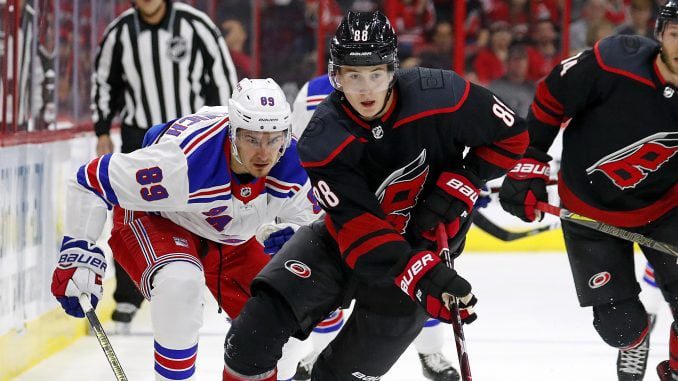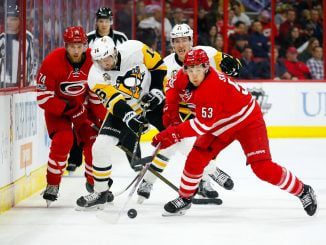
RALEIGH — They say life comes at you fast and for Hurricanes’ 20-year-old forward Martin Necas, that certainly seems to be the case.
Necas lost an edge during Monday’s practice and crashed into the boards, briefly going to the locker room with a sore hip before returning to the ice. The former first round pick seems to hit the ice more than the average player. He even celebrated his first — and, thus far, only — NHL goal last season from his stomach after one-timing a shot past Tampa Bay goalie Louis Dominque.
Necas’ quick feet — his ability to start and stop, quickly accelerate and change directions without slowing — often leave defenders scrambling to keep their skates under them. Even Necas himself sometimes has a hard time keeping up with his legs.
“I guess when you skate really fast you have a tendency to fall more, maybe that’s it,” coach Rod Brind’Amour said following Monday’s two practice sessions.
Many NHL teams have looked at the formula that helped the Bruins and Blues to reach the Stanley Cup Final and tried to copy their blueprint: heavy but skilled players who can withstand the grind of a long season and battle through the tougher checking of the postseason.
The Hurricanes, a team already built on speed, got faster.
Necas is certainly a part of that. The 12th overall pick in 2017, Necas seemed overwhelmed at the start of his first year in North America. He made the Hurricanes out of training camp last season, but after seven games he was assigned to the AHL’s Charlotte Checkers.
The 6-foot-2, 189-pound Czech native adjusted to the smaller rinks and more physical style of play, scoring 16 goals and totaling 52 points for the Checkers in 64 games. He then helped the team to the Calder Cup title, totaling five goals and eight assists in 18 playoff games.
Spending a year in the AHL — like Eric Staal did during the 2005-06 lockout —should give Necas a better chance at making an impact this season. Staal, who had 11 goals and 31 points in his first NHL season in 2003-04, was a point-per-game player in his one year in the AHL during the lost NHL season. He returned to the Hurricanes in 2005 and led the team with a 100-point regular season and helped Carolina to its only Stanley Cup.
Those are lofty benchmarks to set for Necas, but a year in the minors should serve the team’s top prospect well.
“He’s certainly more mature than he was last year on the ice, and off the ice he’s physically more mature. But again, we’ll see how it all comes together when he starts playing for real.”
Adding Necas to the mix this season isn’t the only influx of speed to an already swift lineup.
The Hurricanes traded for center Eric Haula, and he has been centering Necas and Warren Foegele early in camp on a line that is best described as a blur on the ice.
Carolina then signed Ryan Dzingel, who has flanked center Sebastian Aho early in camp on the opposite side of Nino Niederreiter on a top line that looks equally fast.
More speed.
On the eve of training camp, the team made another free agent addition: Jake Gardiner, one of the premier puck-moving defensemen in the league, should be able to activate the team’s speed with his ability to make tape-to-tape passes.
The Hurricanes have looked to add even more pace to their game, reportedly targeting speedy winger Ondrej Kase in talks with the Ducks about Justin Faulk, a trade that fell apart after the Carolina defenseman refused to waive his no-trade clause.
So while Carolina certainly has plenty of pace in its lineup, Brind’Amour knows there’s a difference between having fast players and playing fast.
“I hope we’re fast, but there’s a lot more that goes into it,” he said. “People said we were fast in years past, and we actually weren’t very fast. It’s how you play. You can have a lot of guys that fly around, but if the puck’s not moving and you’re not in the right place, it doesn’t work. On the flip side, you don’t necessarily have to have a bunch of fast skaters to play fast.”
He’s also keenly aware that fast skaters and fast play can lead to success in today’s NHL.
“It’s nice to have both, let’s put it that way,” he added. “And that’s what we’re hoping to have.”



